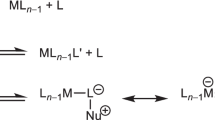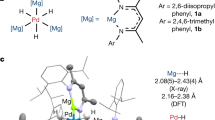Abstract
Diatomic molecules attached to complexed iron or cobalt centres are important in many biological processes. In natural systems, metallotetrapyrrole units carry respiratory gases or provide sensing and catalytic functions. Conceiving synthetic model systems strongly helps to determine the pertinent chemical foundations for such processes, with recent work highlighting the importance of the prosthetic groups' conformational flexibility as an intricate variable affecting their functional properties. Here, we present simple model systems to investigate, at the single molecule level, the interaction of carbon monoxide with saddle-shaped iron– and cobalt–porphyrin conformers, which have been stabilized as two-dimensional arrays on well-defined surfaces. Using scanning tunnelling microscopy we identified a novel bonding scheme expressed in tilted monocarbonyl and cis-dicarbonyl configurations at the functional metal-macrocycle unit. Modelling with density functional theory revealed that the weakly bonded diatomic carbonyl adduct can effectively bridge specific pyrrole groups with the metal atom as a result of the pronounced saddle-shape conformation of the porphyrin cage.
This is a preview of subscription content, access via your institution
Access options
Subscribe to this journal
Receive 12 print issues and online access
$259.00 per year
only $21.58 per issue
Buy this article
- Purchase on Springer Link
- Instant access to full article PDF
Prices may be subject to local taxes which are calculated during checkout




Similar content being viewed by others
References
Spiro, T. G. & Kozlowski, P. M. Is the CO Adduct of myoglobin bent, and does it matter? Acc. Chem. Res. 34, 137–144 (2001).
Collman, J. P., Boulatov, R., Sunderland, C. J. & Fu., L. Functional analogues of cytochrome c oxidase, myoglobin, and hemoglobin. Chem. Rev. 104, 561–588 (2004).
Ghosh, A. Metalloporphyrin–NO bonding: building bridges with organometallic chemistry. Acc. Chem. Res. 38, 943–954 (2005).
Hoard, J. L. Stereochemistry of hemes and other metalloporphyrins. Science 174, 1295–1302 (1971).
Kratky, C. et al. The saddle conformation of hydroporphinoid nickel(II) complexes: structure, origin, and stereochemical consequences. Helv. Chim. Act. 68, 1312–1327 (1985).
Barkigia, K. M., Chantranupong, L., Smith, K. M. & Fajer, J. Structural and theoretical models of photosynthetic chromophores. Implications for redox, light absorption properties and vectorial electron flow. J. Am. Chem. Soc. 110, 7566–7567 (1988).
Barkigia, K. M. et al. Nonplanar porphyrins. X-ray structures of (2,3,7,8,12,13,17,18-octaethyl- and -octamethyl-5,10,15,20-tetraphenyl-porphinato)zinc(II). J. Am. Chem. Soc. 112, 8851–8857 (1990).
Sparks, L. D. et al. Metal dependence of the nonplanar distortion of octaalkyltetraphenylporphyrins. J. Am. Chem. Soc. 115, 581–592 (1993).
Shelnutt, J. A. et al. Nonplanar porphyrins and their significance in proteins. Chem. Soc. Rev. 27, 31–41 (1998).
Senge, M. O. Exercises in molecular gymnastics—bending, stretching and twisting. Chem. Commun. 243–256 (2006).
Weber-Bargioni, A. et al. Visualizing the frontier orbitals of a conformationally adapted metalloporphyrin. ChemPhysChem 9, 89–94 (2008).
Auwärter, W. et al. Site-specific electronic and geometric interface structure of Co-tetraphenyl-porphyrin layers on Ag(111). Phys. Rev. B 81, 245403 (2010).
Springer, B. A., Sligar, S. G., Olson, J. S. & Phillips, G. N. Jr. Mechanisms of ligand recognition in myoglobin. Chem. Rev. 94, 699–714 (1994).
Aono, S. Biochemical and biophysical properties of the CO-sensing transcriptional activator CooA. Acc. Chem. Res. 36, 825–831 (2003).
Kim, H. P., Ryter, S. W. & Choi, A. M. K. CO as a cellular signaling molecule. Annu. Rev. Pharmacol. Toxicol. 46, 411–449 (2006).
Kachalova, G. S., Popov, A. N. & Bartunik, H. D. A steric mechanism for inhibition of CO binding to heme proteins. Science 284, 473–476 (1999).
Sigfridsson, E. & Ryde, U. On the significance of hydrogen bonds for the discrimination between CO and O2 by myoglobin. J. Biol. Inorg. Chem. 4, 99–110 (1999).
Leu, B. M. et al. Quantitative vibrational dynamics of iron in carbonyl porphyrins. Biophys. J. 92, 3764–3783 (2007).
Madura, P. & Scheidt, W. R. Stereochemistry of low-spin cobalt porphyrins. 8. α,β,γ,δ-Tetraphenylporphinatocobalt(II). Inorg. Chem. 15, 3182–3184 (1976).
Auwärter, W. et al. Controlled metalation of self-assembled porphyrin nanoarrays in two dimensions. ChemPhysChem 8, 250–254 (2007).
Meyer, G., Neu, B. & Rieder, K. H. Controlled lateral manipulaiton of single molecules with the scanning tunneling microscope. Appl. Phys. A 60, 343–345 (1995).
Lee, H. J. & Ho, W. Single-bond formation and characterization with a scanning tunneling microscope. Science 286, 1719–1722 (1999).
Auwärter, W. et al. Molecular nanoscience and engineering on surfaces. Int. J. Nanotechnol. 5, 1171–1193 (2008).
Brand, H. & Arnold, J. Recent developments in the chemistry of early transition metal porphyrin compounds. Coord. Chem. Rev. 140, 137–168 (1995).
Smith, P. D., James, B. R. & Dolphin, D. H. Structural aspects and coordination chemistry of metal porphyrin complexes with emphasis on axial ligand binding to carbon donors and mono- and diatomic nitrogen and oxygen donors. Coord. Chem. Rev. 39, 31–75 (1981).
Wahl, P. et al. Kondo effect of molecular complexes at surfaces: ligand control of the local spin coupling. Phys. Rev. Lett. 95, 166601 (2005).
Flechtner, K., Kretschmann, A., Steinrück, H. P. & Gottfried, J. M. NO-induced reversible switching of the electronic interaction between a porphyrin-coordinated cobalt ion and a silver surface. J. Am. Chem. Soc. 129, 12110–12111 (2007).
Barth, J. V. Fresh perspectives for surface coordination chemistry. Surf. Sci. 603, 1533–1541 (2009).
Kresse, G. & Joubert, D. From ultrasoft pseudopotentials to the projector augmented-wave method. Phys. Rev. B 59, 1758–1775 (1999).
Mercurio, G. et al. Structure and energetics of azobenzene on Ag(111): benchmarking semiempirical dispersion correction approaches. Phys. Rev. Lett. 104, 036102 (2010).
Vladimirova, M. et al. Substrate-induced supramolecular ordering of functional molecules: theoretical modelling and STM investigation of the PEBA/Ag(111) system. Acta Mater. 52, 1589–1596 (2004).
Rohlfing, M., Temirov, R. & Tautz, F. S. Adsorption structure and scanning tunneling data of a prototype organic–inorganic interface: PTCDA on Ag(111). Phys. Rev. B 76, 115421 (2007).
Klappenberger, F. et al. Conformational adaptation in supramolecular assembly on surfaces. ChemPhysChem 8, 1782–1786 (2007).
Franke, K. J. et al. Reducing the molecule–substrate coupling in C60-based nanostructures by molecular interactions. Phys. Rev. Lett. 100, 036807 (2008).
Acknowledgements
This work was supported by the European Research Council Advanced Grant MolArt (no. 247299), the Deutsche Forschungsgemeinschaft Cluster of Excellence Munich Center for Advanced Photonics, Canadian National Science and Engineering Research Council (NSERC) and Canada Foundation for Innovation (CFI). W.A., A.W.-B. and J.R. thank the Technische Universität München Institute for Advanced Studies, the German Academic Exchange Service and the Deutsche Forschungsgesellschaft for scholarships, respectively. M.–L.B. acknowledges computational time at the Leibniz Rechenzentrum Garching. N.L. thanks Spanish Ministerio de Ciencia e Innovación for financial support (grant no. FIS2009-1271-C04-01).
Author information
Authors and Affiliations
Contributions
K.S., W.A., A.W.-B. and J.R. performed the STM experiments, and analysed and interpreted the experimental data. The theoretical analysis was provided by M.-L.B. and N.L. J.V.B., W.A. and M.-L.B. conceived the studies and co-wrote the paper with K.S. and N.L.
Corresponding author
Ethics declarations
Competing interests
The authors declare no competing financial interests.
Supplementary information
Supplementary information
Supplementary information (PDF 782 kb)
Rights and permissions
About this article
Cite this article
Seufert, K., Bocquet, ML., Auwärter, W. et al. Cis-dicarbonyl binding at cobalt and iron porphyrins with saddle-shape conformation. Nature Chem 3, 114–119 (2011). https://doi.org/10.1038/nchem.956
Received:
Accepted:
Published:
Issue Date:
DOI: https://doi.org/10.1038/nchem.956
This article is cited by
-
Coral-like Co3O4 Decorated N-doped Carbon Particles as active Materials for Oxygen Reduction Reaction and Supercapacitor
Scientific Reports (2018)
-
Fusing tetrapyrroles to graphene edges by surface-assisted covalent coupling
Nature Chemistry (2017)
-
n and p type character of single molecule diodes
Scientific Reports (2015)
-
Porphyrins at interfaces
Nature Chemistry (2015)
-
A bio-inspired Co3O4-polypyrrole-graphene complex as an efficient oxygen reduction catalyst in one-step ball milling
Nano Research (2015)



